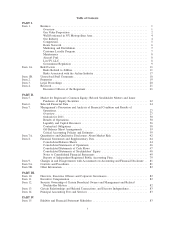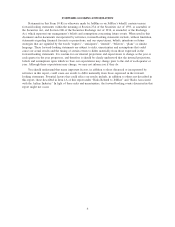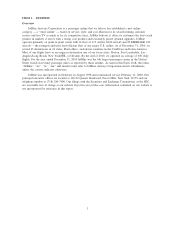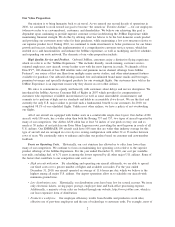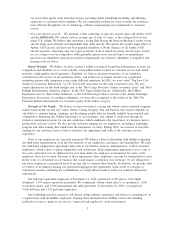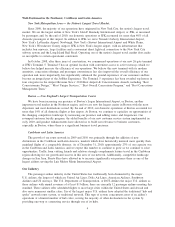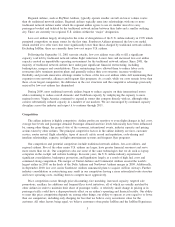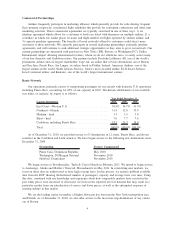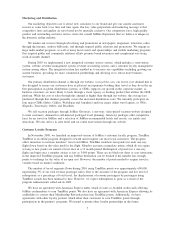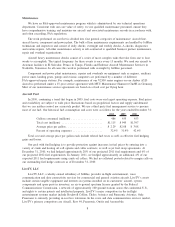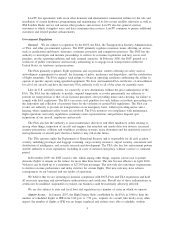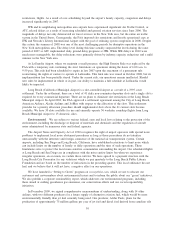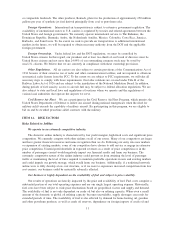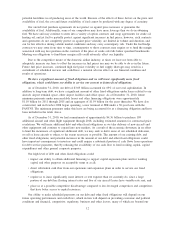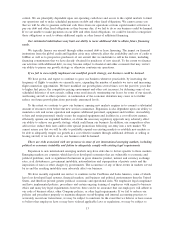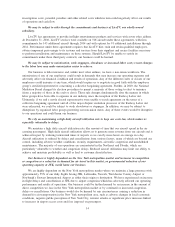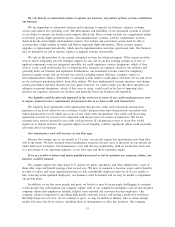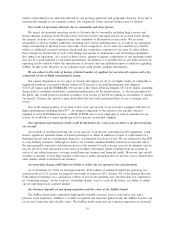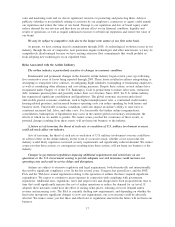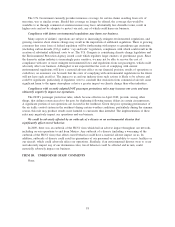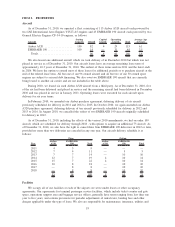JetBlue Airlines 2010 Annual Report Download - page 18
Download and view the complete annual report
Please find page 18 of the 2010 JetBlue Airlines annual report below. You can navigate through the pages in the report by either clicking on the pages listed below, or by using the keyword search tool below to find specific information within the annual report.LiveTV has agreements with seven other domestic and international commercial airlines for the sale and
installation of certain hardware, programming and maintenance of its live in-seat satellite television as well as
XM Satellite Radio service and certain other products and services. LiveTV also has general aviation
customers to which it supplies voice and data communication services. LiveTV continues to pursue additional
customers and related product enhancements.
Government Regulation
General. We are subject to regulation by the DOT, the FAA, the Transportation Security Administration,
or TSA, and other governmental agencies. The DOT primarily regulates economic issues affecting air service
such as certification and fitness, insurance, consumer protection and competitive practices. The DOT has the
authority to investigate and institute proceedings to enforce its economic regulations and may assess civil
penalties, revoke operating authority and seek criminal sanctions. In February 2000, the DOT granted us a
certificate of public convenience and necessity authorizing us to engage in air transportation within the
United States, its territories and possessions.
The FAA primarily regulates flight operations and, in particular, matters affecting air safety such as
airworthiness requirements for aircraft, the licensing of pilots, mechanics and dispatchers, and the certification
of flight attendants. The FAA requires each airline to obtain an operating certificate authorizing the airline to
operate at specific airports using specified equipment. We have and maintain FAA certificates of airworthiness
for all of our aircraft and have the necessary FAA authority to fly to all of the cities we currently serve.
Like all U.S. certified carriers, we cannot fly to new destinations without the prior authorization of the
FAA. The FAA has the authority to modify, suspend temporarily or revoke permanently our authority to
provide air transportation or that of our licensed personnel, after providing notice and a hearing, for failure to
comply with FAA regulations. The FAA can assess civil penalties for such failures or institute proceedings for
the imposition and collection of monetary fines for the violation of certain FAA regulations. The FAA can
revoke our authority to provide air transportation on an emergency basis, without providing notice and a
hearing, where significant safety issues are involved. The FAA monitors our compliance with maintenance,
flight operations and safety regulations, maintains onsite representatives and performs frequent spot
inspections of our aircraft, employees and records.
The FAA also has the authority to issue maintenance directives and other mandatory orders relating to,
among other things, inspection of aircraft and engines, fire retardant and smoke detection devices, increased
security precautions, collision and windshear avoidance systems, noise abatement and the mandatory removal
and replacement of aircraft parts that have failed or may fail in the future.
The TSA operates under the Department of Homeland Security and is responsible for all civil aviation
security, including passenger and baggage screening, cargo security measures, airport security, assessment and
distribution of intelligence, and security research and development. The TSA also has law enforcement powers
and the authority to issue regulations, including in cases of national emergency, without a notice or comment
period.
In December 2009, the DOT issued a rule, which among other things, requires carriers not to permit
domestic flights to remain on the tarmac for more than three hours. The rule became effective in April 2010.
Violators can be fined up to a maximum of $27,500 per passenger. The new rule also introduces requirements
to disclose on-time performance and delay statistics for certain flights. This new rule may have adverse
consequences on our business and our results of operations.
We believe that we are operating in material compliance with DOT, FAA and TSA regulations and hold
all necessary operating and airworthiness authorizations and certificates. Should any of these authorizations or
certificates be modified, suspended or revoked, our business could be materially adversely affected.
We are also subject to state and local laws and regulations in a number of states in which we operate.
Airport Access. In January 2007, the High Density Rule, established by the FAA in 1968 to limit the
number of scheduled flights at JFK from 3:00 p.m. to 7:59 p.m., expired. As a result, like nearly every other
airport, the number of flights at JFK was no longer regulated and airlines were able to schedule, without
9


